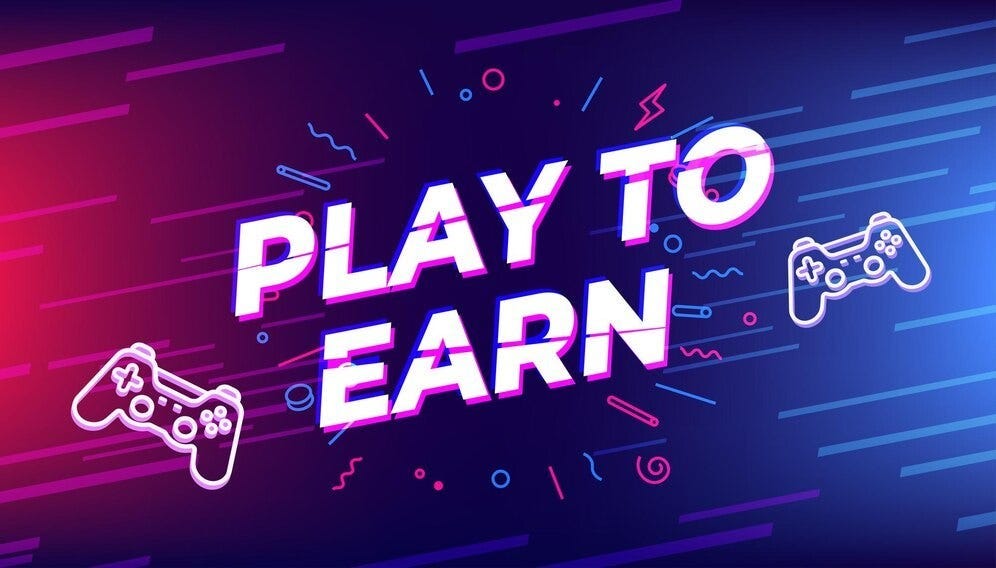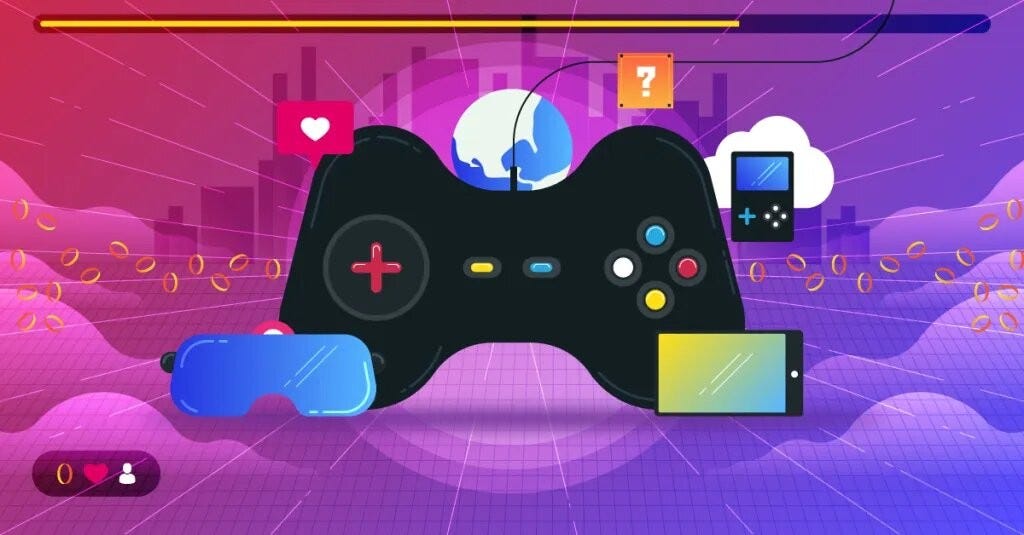Regenerative Finance (ReFi): Paving the Way for a Sustainable Future
 Revolutionizing Gaming: From Pay-to-Play to Earning Real Money in the Metaverse
Revolutionizing Gaming: From Pay-to-Play to Earning Real Money in the MetaverseUnlock the secrets of the gaming world’s evolution from traditional Pay-to-Play to the groundbreaking Play-to-Earn and Move-to-Earn models. Explore the intersection of Web3, NFTs, and digital currencies, discovering how gamers can now monetize their skills and even make a living by playing. Delve into the realms of decentralized gaming, Metaverse casinos, and the rise of NFTs as in-game assets. Whether you’re a serious gamer, crypto enthusiast, or just curious about the future of gaming, this article is your guide to the next frontier in interactive entertainment.
The Definition Of “Pay To Play”
Even in the realm of digital entertainment, the pay-to-play paradigm is the norm. Video games that follow the pay-to-play business model are similar to freemium games, with the exception that players must spend real money to get access to certain in-game content.
Most gambling games need registration and a real-money payment before they can be played, thus the notion of paying to access games is straightforward for the ordinary online casino player. For games that don’t include money, however, this approach is best applied to traditional MMORPGs like World of Warcraft and Eve Online.
The free-to-play model is the antithesis of the pay-to-play model, since users may get access to the game, play it, and enjoy the vast majority of its content without spending any money. There is always an exclusive section of the narrative for those who are ready to pay more to access more features. Although most online players prefer F2P games, the popularity of Pay to Play gaming is growing among serious gamers throughout the globe.
Monthly subscription fees are the foundation of the pay-to-play business model. It’s easy to understand since it functions similarly to online gaming subscriptions. Through a subscription-based gaming model, players pay to get access to a variety of in-game features.

How Do P2P Games Work?
The vast majority of games that require payment to play are massively multiplayer online role-playing games (MMORPGs). Popular pay-to-play games include World of Warcraft, Eve Online, and RuneScape, which are available for both free and paid play.
How does it all function, then? A gamer essentially pays the game’s developer a monthly fee to keep their account active. The game will be inaccessible until the charge is paid.
Game developers have come to realize in recent years that this strategy, although lucrative on its own, is most effective when coupled with freemium models. Among the many examples of a hybrid paradigm, the fantasy video game RuneScape stands out.
The play-to-earn concept may alter the status quo by returning revenue from gaming corporations to the gamers themselves.
The Definition Of Play To Earn
The play-to-earn concept is based on empowering gamers monetarily while making the gameplay interesting with exciting crypto rewards. There are a variety of ways players can earn rewards via different activities, including regular gameplay, participation in special events, and completing in-game activities.
Participants may, in essence, win real money by taking part in the game. Play to Earn games also involve selling and collecting in-game items such as NFTs and cryptocurrencies.

How Do P2E Games Function?
To provide a satisfactory response to this inquiry, we may need to go into the topic of the three primary components required for play-to-earn games to function.
NFT — the exclusive tokens available for exchange and sale.
The blockchain looks after all cryptocurrency transactions.
Play-to-earn games are played in Web3 as well as the Metaverse.
Why Do Non-Fungible Tokens Matter in Play-to-Earn Crypto games?
In any case, NFTs have become in-game elements for the play-to-earn model’s inner workings. The strategy assumes that users will engage with the game, amass in-game assets, and then trade those assets for real-world currency. One of the first prominent instances of P2E is the game, Axie Infinity.
Players in Axies get to use special potions to create small creatures called “Axies.” Each Axie represents a separate NFT that may be used to create the elixir at a later time. But the real hook is the potion: it’s not just any potion, it’s a cryptocurrency that can be traded for real money after you’ve collected enough of them in-game.
Since they are NFTs, they may be bought and sold using Ethereum or any other cryptocurrency. Check out the value of Play-to-Earn tokens if you don’t trust us and think NFTs are nothing more than internet mumbo jumbo. In-game non-fungible tokens, or NFTs, known as Axie Infinity tokens, will appear. Earned in-game, they may be traded for other cryptocurrencies like Bitcoin which you can easily trade from Bitcoin Rush.
Conclusions :-
There have been discussions about bridging the gap between the NFT and crypto communities and the online casino industry. These emerging gaming concepts might lead to a model in which users can gamble in a virtual environment and earn NFTs or cryptocurrencies that can be converted into fiat cash. Thus, a decentralized approach to gaming can truly empower gamers across the globe.
The most likely route is the Metaverse gambling sector, which might encourage a new generation of gamers to adopt crypto and NFTs for their gaming needs.
One of the most visited Metaverses, Decentraland, is reportedly in the works of building a casino. Customers may wager their crypto at these casinos in the hopes of winning NFTs. There would be a lot more advancements in the years ahead, as the gaming industry has been rapidly evolving, attracting more and more gamers.
Table of Contents
1. What is Play to Earn?
2. What is Play to Own?
3. Play to Earn vs Play to Own: Comparison
4. Play to Earn vs Play to Own: Differences in Tokenomics and Game Mechanics
5. Play to Earn vs Play to Own: Which one is better?
6. Conclusion
Have you ever wanted to be rewarded for the games you play? The rise of blockchain is now making the unthinkable possible. Several strategies to earn rewards from games have gained popularity in the gaming industry. Two such strategies that have gained immense popularity are “Play to Earn” and “Play to Own.” In this article, we will explore the differences between these two approaches and help you decide which one is the best fit for you.
What is Play to Own?

Play to Own, on the other hand, focuses on the ownership aspect of gaming. In traditional gaming, players invest their time and money into acquiring in-game assets or virtual items. However, these items remain within the confines of the game’s ecosystem. Play to Own games — powered by blockchain technology — enable players to truly own their in-game assets.
By leveraging blockchain’s decentralized nature, Play to Own games use non-fungible tokens (NFTs) to represent unique and indivisible digital assets. These NFTs can be bought, sold, and traded outside the game environment, giving players full control and ownership of their possessions. This ownership offers players a sense of rarity and scarcity, as NFTs are often limited in quantity.
Play to Earn vs Play to Own: Comparison

While both P2E and P2O involve earning rewards and owning in-game assets, they differ in their core focus. Play to Earn emphasizes earning an income through gaming, while Play to Own prioritizes ownership and control over virtual assets.
On the other hand, if you have a keen interest in collectables and digital ownership, Play to Own games provide a unique experience. Owning scarce and verifiable digital assets can be exciting, and the possibility that their value appreciates over time makes it an attractive proposition for collectors.
Play to Earn vs Play to Own: Differences in Tokenomics and Game Mechanics
The differences between Play to Earn and Play to Own can also be seen in their underlying tokenomics and game mechanics. Play to Earn games often rely on a native cryptocurrency or token within the game ecosystem. These tokens can be earned through gameplay or purchased, and their value may fluctuate based on market demand and other factors. Players can then convert these tokens into real-world currency or trade them for other assets.
On the other hand, Play to Own games leverage blockchain technology to create verifiable digital assets represented by NFTs. These assets are often unique and indivisible, ensuring their scarcity and value. The ownership of these assets is recorded on the blockchain, providing transparency and security. Players can freely transfer, trade, or sell their NFTs on various blockchain marketplaces.
Play to Earn vs Play to Own: Which one is better?

Determining whether Play to Earn or Play to Own is better depends on individual preferences and goals. If you enjoy competitive gaming and want to monetize your skills, Play to Earn games offer the opportunity to earn real-world rewards. It can be an appealing option for those looking to make money while doing something they love.
On the other hand, if you have a keen interest in collectables and digital ownership, Play to Own games provide a unique experience. Owning scarce and verifiable digital assets can be exciting, and the possibility that their value appreciates over time makes it an attractive proposition for collectors.
Ultimately, the choice between Play to Earn and Play to Own comes down to personal preference and goals. It’s worth exploring both options to determine which strategy aligns better with your interests and aspirations.
Conclusion : -
The gaming industry continues to evolve, and innovative concepts like Play to Earn and Play to Own are reshaping how players interact with games. Play to Earn allows gamers to monetize their skills and time spent playing, while Play to Own focuses on ownership and the rarity of virtual assets. Both strategies offer unique benefits and opportunities for players.
The rise of Play to Earn and Play to Own reflects a broader trend in the gaming industry toward greater player empowerment and ownership. As blockchain technology continues to advance, we can expect more innovative games and concepts that blend the virtual and real worlds.
Play-To-Earn Vs Move-To-Earn: A Comprehensive Comparison?
Play-to-Earn vs Move-to-Earn: The P2E model rewards metaverse gameplay, whereas the M2E model rewards user movement in the real world.
Play-to-Earn vs Move-to-Earn
Play-to-Earn vs Move-to-Earn: Current hot topics in the blockchain gaming sector include the Play-to-Earn (P2E) and Move-to-Earn (M2E) trends. However, these are significant contributions of the NFT Blockchain to humanity. These two emerging fields are anticipated to alter how we communicate through video games. The global expansion of the gaming industry can greatly benefit users and communities thanks to blockchain technology.
What is Play-to- Earn?
Play-to-Earn (P2E) combines blockchain technology and gaming. P2E games pay users in-game tokens for their progress. These tokens can be exchanged for cryptocurrency assets that have applications outside the gaming industry. Usually, the rewards are related to the player’s performance in the game. Developers of P2E games, which have grown in popularity since the start of 2021, include Sandbox and Axie Infinity. Spliterlands, Chainmonsters, etc. are other notable P2E projects.
Examples of Play-to-Earn games : -
The Ethereum blockchain-based video game Axie Infinity is among the most well-known examples of a Play-to-Earn game. It combines gameplay elements from video games and blockchain.
Another illustration of a P2E game is Aavegotchi. As an open-source, community-owned NFT gaming protocol, it describes itself. In pixelated ghost form, users can embark on adventures that are reminiscent of Tamagotchi games.
The Sandbox is a different game in the P2E sector. This platform provides its users with a distinctive gaming experience that allows them to get a preview of what the Metaverse most likely will resemble. Users can design, build, and play with the future.
Also Read: SHIBA Inu Metaverse: How do I get metaverse Shiba Inu?
What is Move-to-Earn?

Move-to-Earn (M2E) apps let users earn cryptocurrency by being active in sports and fitness activities. Unlike Play-to-Earn (P2E) games that reward gaming skills, M2E focuses on physical activity instead of sitting in front of screens. Most M2E apps use decentralized finance (DeFi) features to reward users and involve them in the platform’s outcomes.
Examples of Move-to-Earn (M2E) games include:
1. STEPN: A well-known M2E project on Solana, STEPN is a Web3 app that combines GameFi and SocialFi features. It rewards users for being healthier and wealthier by encouraging them to take steps.
2. Sweatcoin: Users earn the platform’s native currency, SWEAT, by running, walking, and sweating. The reward is given after completing 1000 steps.
3. MetaGym: This M2E project lets users make money while exercising through its app and smartwatch application. Users can earn MetaGym Coin (MGCN), the platform’s own token, by utilizing GameFi, FitFi, and SleepFi features during workouts.
Differences between Play-to-Earn (P2E) and Move-to-Earn (M2E):
1. Sustainability: Both P2E and M2E face questions about their long-term viability. Creating a sustainable in-game economy is a challenge, especially for M2E, where users often need to pay to play or move. P2E games are more established and sophisticated.
2. Popularity: P2E games, set in virtual metaverse worlds like Decentraland, are currently more popular and integrated with NFTs. In contrast, M2E games face competition from established fitness apps and need to convince users they’re not Ponzi schemes.
3. Reward System and Earning: While both may seem similar to users, they differ in how they reward. P2E rewards players based on their in-game performance, while M2E rewards users for physical activity in the real world. P2E is more game-focused, while M2E is a fun activity requiring physical participation.
Conclusion : — In summary, traditional games used a closed model where players paid upfront, grinded for in-game rewards, but had limited control over their assets. The shift to decentralized games, like Play-to-Earn and Move-to-Earn, is a natural progression. These models empower users, providing more control and acknowledging their efforts in a democratic gaming approach.
Revolutionizing Gaming: From Pay-to-Play to Earning Real Money in the Metaverse was originally published in Coinmonks on Medium, where people are continuing the conversation by highlighting and responding to this story.
